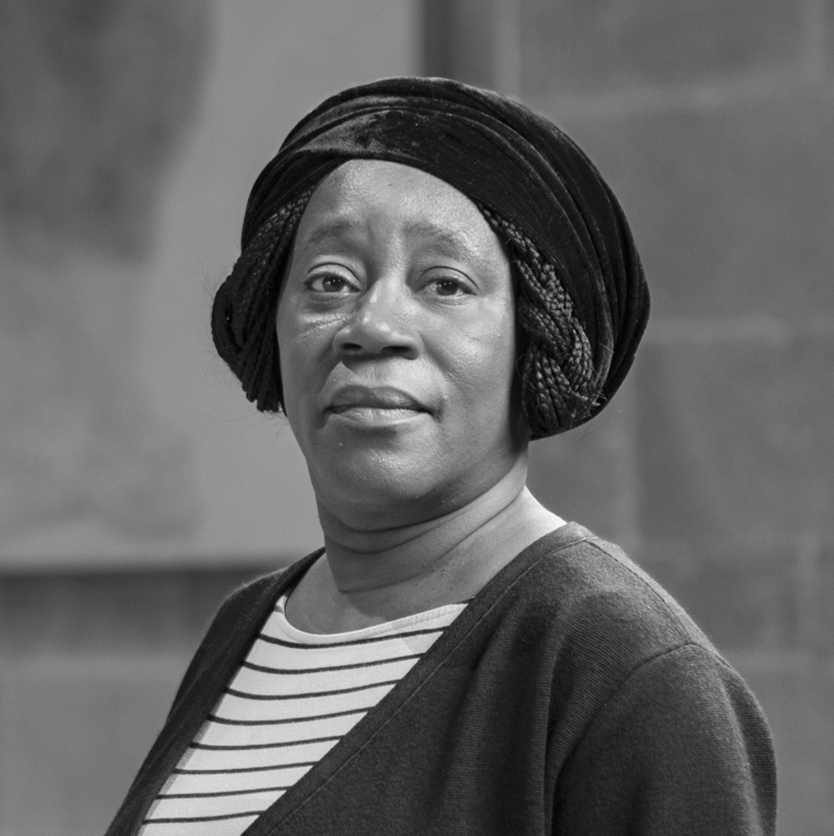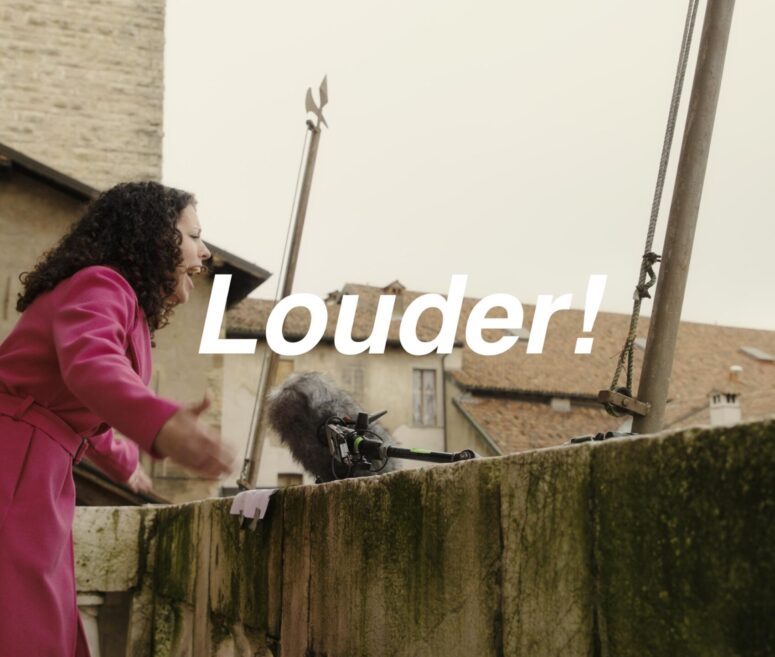Introduction by Brandon LaBelle [1]
As in Boyce’s previous work, Feeling Her Way—presented at the British Pavilion as part of the Venice Biennale in 2022—song is featured in ways that capture the sense in which individual voices become carriers of personal histories; the granularity of the voice, as Roland Barthes invites us to appreciate, exposes persons as living breaths, as full of experience, and which singing draws forward in profoundly moving ways. Moreover, in Boyce’s works individual voices are positioned to also participate in a greater ensemble—the artist is particularly engaged with composing in ways that suggest voice is not quite singular, not quite self-possessed. Rather, voices multiply to support each other; they overlap, intersect, and harmonize but also interfere with each other; they are threaded with other sounds, with musical instruments performed and recordings mixed; voices are situated, positioned, placed within architectures and environments whose resonances carry the voice, granting active forms of listening. This finds further iteration in the presentation of Benevolence, in which recorded voices partner in consonant and dissonant ways. Even the sound of an individual voice is duplicated and composed across multiple channels to partner with itself.
The understanding of voice as singular and plural, as individual and multiple, is elaborated in Adriana Cavarero’s philosophical work.[2] Tracing a greater history of ideas (within a Western context) on the question of voice, Cavarero argues on behalf of voice as the very thing through which the individual is recognized as a “unique being.” Against the legacy of platonic thinking, which relegates voice to a pure notion of logos, and the verbal articulation of ideas, Cavarero seeks to recover voice as breath, a reverberation of embodied living persons, where the sounding of voice extends beyond linguistic capture. Moreover, the uniqueness of being that she highlights as central to vocalization is positioned in ways that extend beyond a strictly “individualistic” view—the phonic uniqueness of voice emerges as what expresses the value of each voice, and therefore as contributing to a greater human community. For the sounding of one voice is always already the hearing of others.
There are voices in Boyce’s work—voices that carry themselves into the public square, carry the lyrics and melodies of history and its meanings, lyrics written by others that pass through others’ voices. What kinds of resonances emerge there, in the Piazza Vecchia? In the singing that seeks out the cavities of history, to call forth a responsive movement in others—of recollection and recuperation, to awaken the ghosts of history as guides in our contemporary struggles? The voices that resound in Benevolence are voices that sound against the backdrop of broken times, recalling not only the collective scenes of singing from balconies enacted by citizens in Bergamo, and across Italy, during the COVID-19 lockdowns in 2020 and 2021, not only these poignant rituals that worked against death and loneliness, but also histories of the twentieth century’s world wars and the partisan soldiers that fought in the mountains surrounding the city, and whose songs came to gather history in their felt lyrics, calling forth pride and resistance in the hearts of a population—and beyond. As Boyce highlights, the partisans’ songs are continuously evoked as markers of resistance and popular uprising. From “Il testamento del Capitano” to “Bella Ciao,” the freedom fighters’ songs capture the imagination of activists and citizens alike, spiriting a sense of urgency surrounding anti-fascist struggles, along with the vulnerability inherent to democracy and the power of people. [3]
These are movements of sounded expression that resonate across time and space to breathe new life into a range of histories, memories, hopes, and fears. They come to fill the voice with an ache of remembrance. Is not the voice called upon to carry the burden of memory? To negotiate and account for personal traumas, as well as contend with greater collective experiences? In all its resonating reach, its whispered words and guttural outpouring, voice labors at the weight of memory and history to bring forward ways of remaking worlds and identities. These are the movements carried in Boyce’s work, which are woven into a lyrical composition comprised of audiovisual recordings of the live performances. Installed in the Palazzo della Ragione, Benevolence carefully situates itself within the architecture of the former courthouse. From the public square of the old town to the architecture of the exhibition space, Benevolence balances itself as both public intervention and sited installation, as performative event and multichannel composition, inviting audiences into a time and space of listening, viewing, experiencing. By way of such an engaged process, the artist weaves together research and reflection with the living dynamics of people and community, contending with the violences shaping history while retaining hope for the future. By way of voices and their spirited vocalizing—their capacity to carry the fleeting stories of historical events, to carry them in the resonant folds of body and lung—the work enacts a gesture of care, one that aims at contending with the emergence of new forms of fascism today.
Brandon LaBelle
[1] This introduction is an excerpt from Brandon LaBelle’s commissioned essay on Sonia Boyce’s Benevolence: The Joy of Cacophony (Milan: Lenz, 2024).
[2] Adriana Cavarero, For More Than One Voice: Toward a Philosophy of Vocal Expression (Stanford, CA: Stanford University Press, 2005).
[3] Ethnomusicologist Ana Hofman provides an important analysis into the ways in which partisan songs have been “re-purposed” by activist groups and choirs in former Yugoslavia in recent years. Hofman suggests that practices of “re-sounding” anti-fascist resistance enables the carving out of new affective political channels and spaces that assist in overcoming “feelings of uncertainty,” or what the author terms “political exhaustion.” For more see: Ana Hofman, “Disobedient: Activist Choirs, Radical Amateurism, and the Politics of the Past after Yugoslavia,” Ethnomusicology 64, no. 1 (Winter 2020).
How would you describe the typical situation leading up to the elaboration of a project? What phases are most recurrent in the project elaboration process?
My methods over the past few decades—or the process for creating artworks—are similar, but always with seemingly different outcomes. These different outcomes are often dependent on the variety of people I work with for each project and their response to the invitation to collaborate or take part in an unrehearsed performance. Improvisation and spontaneity are key. The fact that we are often strangers to each other is another recurrent factor—although, I have been working with a director of the filming (Michelle Tofi) and a producer of the project (Niamh Sullivan) for many years. My aim, I suppose, is to foster a temporary community where differences are overcome to achieve something productive together.
I try not to direct what unfolds during the performances. This includes not directing the film crew who are there to capture what takes place, although there is a lot of background preparation so that they can respond technically and creatively to what takes place. There are often several complex—and sometimes competing—factors at play when trying to encourage creative interaction on the one hand, and to remain respectful of each contribution and the wider social context on the other.
After the performance has taken place and has been documented, the next stage is to take the material gathered on another creative and hopefully intuitive journey. In this post-production phase, of which there are several technical processes, I am concerned with whittling (carving the documentation) and collaging (juxtaposing) different elements for its display in a gallery context.
What do you hope communities will gain from experiencing your works?
On an immediate level, I hope that those who experience the work are touched, first and foremost, by the work’s emotionality. Also—and this is something that emerges in all my works—its political or cultural questions about collective and individual human agency.
I try to resist a direct and didactic message, and hope those who experience the work bring their own perspective and understanding.
And what, instead, do you hope they will unlearn from you? Is there a particular ideology you’re hoping to dismantle?
Certainty. A firm conviction that things, people, and responses are fixed and fully knowable. I often ask collaborators and participants to move beyond their expectations about themselves. I also hope that there is an opening, a portal, for those who experience the work. But I can never be sure.
Who are the thinkers that inspire your work?
I have long been interested in the work of French philosopher, Michel Serres (1930–2019) and his book The Parasite, where he argues that by being considered a pest (grit in the ointment) as part of a minority group—in my case a black female artist coming from the UK—that it is possible to become a major influencer in public discourse. Thus, creating diversity and complexity that is vital to human life and progressive thought. Noise and sound as interruptive moments that create communication networks are key markers in his book The Parasite.
The Russian philosopher, Mikhail Bakhtin (1895–1975) and his ideas about the carnivalesque and polyphony: meaning a plurality of voices, perspectives, and freedom continues to be influential in my creative process.
The Brazilian artist, Lygia Clark (1920–1988) has greatly influenced my art practice. With her works, there is a constant opening outward to others with no fixed orientation, but that her artworks are rooted in the body and its senses.
Brandon LaBelle, an American artist and writer living in Europe, continues to have a profound impact on my thinking with his books Background Noise and Sonic Agency. And I am just getting to know the experimental sound work of Pauline Oliveros (1932–2016) and her perspective on deep listening as a form of activism, alongside the intellectual rigour of Louis Chude-Sokei and his book The Sound of Culture: Diaspora and Black Technopoetics.
Last, but by no means least, I have recently been introduced to the Pattern and Chaos Research Group at Norwich University of the Arts in the UK. They have just published a book Pattern and Chaos in Art, Science and Everyday Life, which helps me tease out my own questions about my relationship to repeat patterns and my impulse for unwieldy improvisational performances.
In what way does your practice help us imagine new worlds or a more habitable world?
Polyphony, as a philosophical concept, asks us how might we accommodate different perspectives rather than a monolithic position? However, it is not, per se, about conflict resolution. Conflict resolution, which is a professional skill set and therapeutic process, seeks to find a cordial solution to a problem of divergent (and often negative) ways of being together. Polyphony seeks a sensitivity and awareness of a spectrum of positions and perspectives. It doesn’t propose a solution to ameliorating those differences, but asks for sensitivity rather than polarisation.
Credits: Still da video

Note biografiche
Sonia Boyce DBE RA (b. London, 1962) is an interdisciplinary artist and academic working across film, drawing, photography, print, sound, and installation. In 2022 she presented FEELING HER WAY, a major commission for the British Pavilion at the 59th International Art Exhibition – La Biennale di Venezia for which she was awarded the Golden Lion for Best National Participation. Boyce came to prominence in the early 1980s as a key figure in the burgeoning British Black Arts Movement with figurative pastel drawings and photo collages that addressed issues of race and gender in Britain. Since the 1990s, however, Boyce has shifted significantly to embrace a social practice that invites improvisation, collaboration, movement, and sound with other people. Working across a range of media, Boyce’s practice today is focused on questions of artistic authorship and cultural difference. In 2016, Boyce was elected to the Royal Academy of Arts in London and in 2023, she was elected to the American Academy of Arts and Science in Boston. Since graduating in the early 1980s Boyce has consistently worked within the art school context. In 2014 she became a Professor at University of the Arts London, where she holds the inaugural Chair in Black Art & Design. A three year research project into Black Artists and Modernism culminated with a 2018 BBC documentary Whoever Heard of a Black Artist?, exploring the contribution of overlooked artists of African and Asian descent to the story of modern British art. In the King’s New Year Honours List of 2023, Boyce was awarded a Damehood.





